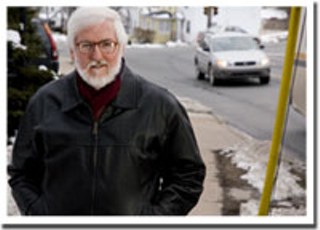As far as Kevin Moynihan is concerned, there’s a battle going on in HRM these days between people and cars. “As of right now,” he says, “cars are winning.”
As one of the residents directly affected by the Chebucto Road widening project, Moynihan is in a position to know. If the project, approved in an HRM council vote on March 27, goes through as planned, Moynihan stands to lose 700 square feet of property and the battle will be right at his front door.
Yet, Moynihan says he and others in the Chebucto Neighbourhood Association are less concerned with the loss of property than they are with the loss of quality of life. By widening Chebucto enough to allow for a reversible lane leading to and from the Armdale Rotary, the municipality hopes to increase traffic flow through the area—more cars, moving faster. And that, says Moynihan, is exactly the problem.
“We consider this a major safety issue. This is an old neighbourhood with lots of moms with small kids, and seniors,” he says. “There are two schools in the area, including a special-needs school, there’s a church, there’s all the pedestrian traffic from Halifax Shopping Centre. We’re a neighbourhood, not a traffic artery. But that concern has been dismissed from the very beginning.”
From the start, Moynihan feels the battle over Checbuto Road has been one-sided. The first indication residents had that something was happening was a letter sent from HRM Real Estate Services in November 2005. It indicated that “to facilitate construction of this project” the 12 recipients of the letter would be required, as per the Provincial Expropriation Act, to sell all or part of their properties to HRM. The letter stated HRM “was allowed to acquire property that HRM requires for its purposes, and HRM acquires property for ‘fair market value,’” The next notice, in late January 2006, came in the form of actual monetary offers for the properties involved. Until that point, there had been no meetings with property owners on the matter and it is clear from the letters HRM considered both the road project and financial arrangements to be a done deal.
Within the month, property owners presented a petition to council with the signatures of 200 area residents opposed to the plan. It was not until April 2006—eight months after property owners had been notified that the municipality intended to take their land—that a general notice was sent saying HRM would hold a public meeting on the matter (under the Act, public hearings on land expropriation are not required). Five days later, area residents formed the Chebucto Neighbourhood Association to fight the project.
The CNA believes the wiser course of action would be to create High Occupancy Vehicle lanes on the existing Chebucto roadway, thus moving the same number of people into the city with less traffic.
“From our information, HOV lanes would take a couple hundred cars per hour off Chebucto Road,” says Moynihan. “It would be a cheap, simple solution rather than knocking down people’s houses.”
Although the CNA is determined to fight on, the Expropriation Act leaves them with few options. Under the Act, once the decision to expropriate has been confirmed by council’s vote, residents can contest the financial settlement and ask for negotiation through the Utilities and Review Board, but not the expropriation itself.
“From the very beginning we felt this was a protest based on principle, on public consultation, on public participation and just common sense, that if you make roads wider and faster, more people will drive their cars into the city,” he says. “And we still feel there are principles here to keep fighting for, so we’re coming up with strategies to engage the public imagination.”
Moynihan feels that with the decision to put down pavement, HRM is bucking a trend in global urban thinking.
“Other cities are trying to lessen traffic flow into downtown and here we’re doing the exact opposite,” he says, citing as prime examples Boston’s “Big Dig” project, where a highway that split the downtown core of the city was removed, and London’s fees for driving into the capital’s centre. “This plan to widen Chebucto first came up in 1972. It’s an old idea that no longer works.”
We have a forum for discussing this topic here.












